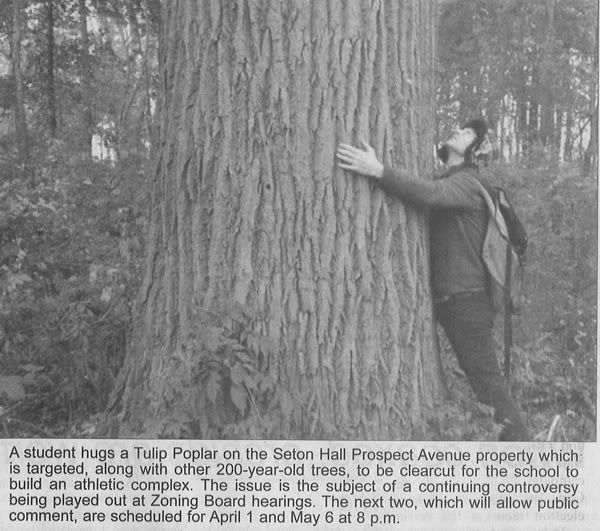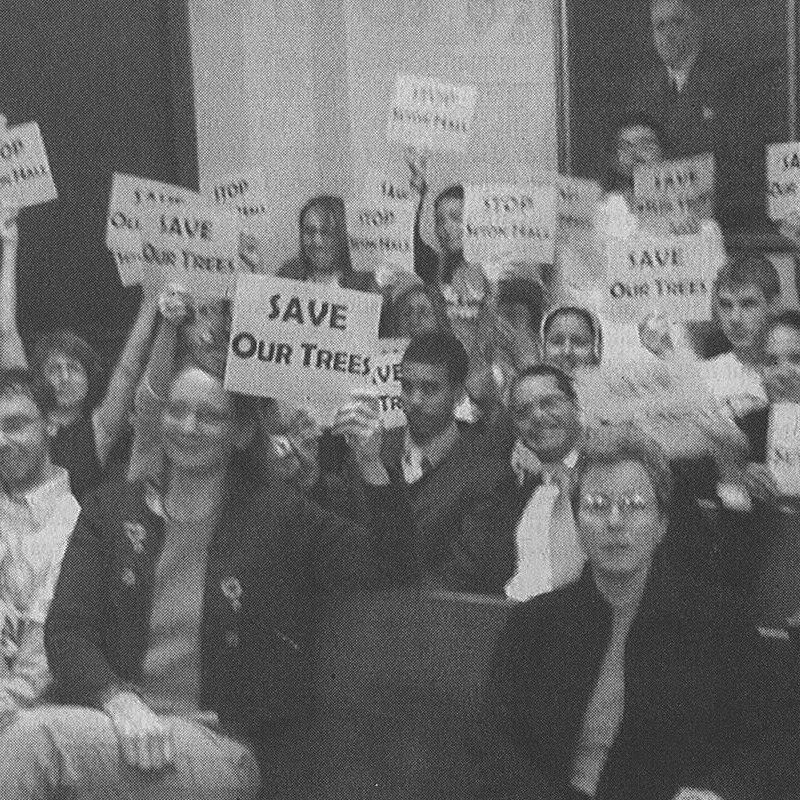(noon. – promoted by ek hornbeck)
 A student with one of the trees |
Never underestimate the power of a small but committed group of people to change the world. Indeed, it is the only thing that ever has.” – Margaret Mead
This is another update of a the original piece Save the Trees. The first update was DK Greenroots: Saving the trees…and maybe the bats.
Here in West Orange, NJ, past home of Thomas Alva Edison and present home of Whoopi Goldberg, a small but committed group of people is fighting the powers that be…in this case the West Orange Zoning Commission and Seton Hall Prep (and through it, the Archdiocese of Newark) in order to prevent the demolition of McClellan Old-Growth Forest in order to build sports fields.
I’m posting tonight in order to provide a conduit between those local voices and a larger community of activists. At least I hope so.
Jim Scott: The Rain Forest Song |
First up we have Loren Svetvilas, reporting on the April 15 meeting.
We had a fireball of an evening, with many objectors firing beautiful statements in support of the forest, in support of our community, against SHP’s reputation as a good neighbor, to ‘testify’ about the impact that their first phase has had on homes with regards to flooding and damage, as well testimony in excellent detail about how this forest works.
For example, a gentleman who is both a resident and a Rutgers professor of 48 years, spoke in great, simplistic detail about how these trees ‘operate’ in removing storm water and toxins. He spoke of an 80-foot oak containing 50% water, and 50% hydrogen and carbon. If the tree weighs 8000 pounds, that means the tree contains 4000 pounds of water. A forest of this magnitude, in this region processes 50-60 million gallons of water/year. He challenged the board or anyone else to design a water detention system that could process that much water. He said under oath that it simply can’t be done.
We heard a very pointed argument from Sally Malanga in support of this forest, as well a woman who came to speak “for the trees”, and tied in an interfaith approach. We heard from another neighbor who ironically is a 2006 graduate of SHP, who spoke of the continual damage from their first phase, and how it will only get worse if this second phase is approved. He also spoke of the distrust he has for the school. Two women spoke to the nature of their water damage, and the lack of response from the town. Another
neighbor questioned the board (very appropriately) about why we are even here. There is litigation in court regarding their first phase, and this project should be tabled until that’s settled. Period. The board didn’t like being questioned!It was just a fabulous evening. The best part may have been when the board asked if there were anymore speakers who support the project. No one raised their hand. The objectors kept speaking, and the evening closed with four more objectors (including my wife and myself) providing our names so we can speak at the next hearing, on May 6th. At that time, I will present the petition.
Oh yes, the speakers for SHP presented the same old song: the boys need the fields, SHP is a good neighbor, and sports is important in a young man’s growth. It’s to the point where they could just play a tape recorder. How many SHP students have come out to speak in support of the fields? One.
–Loren Svetvilas
At the March meeting of the Zoning Board, we had testimony from students, including Nirva Singh, representing the Bergen Community College Environmental Club.
 West Orange Zoning Board Meeting |
We students are very concerned about the state of this planet. We are here fighting for our future. Try to understand, losing your future is not like losing a couple of points on the stock market or losing a baseball game. We are here to speak for all the generations to come. We are here to speak for countless animals dying across this planet because they have nowhere left to go. In our lifetime the amount of carbon dioxide in the atmosphere has never increased like it is increasing now. The oceans have never been so polluted and habitat destruction has never been so rampant.
These days I am afraid to stand in the sun too long because of the giant hole in the ozone layer. I am afraid to breathe the air in my neighborhood and drink the water in my local stream, because I do not know what chemicals are in it.
The global extinction rate has reached historic proportions. We now face the sobering fact that a species of plant or animal is becoming extinct every 20 minutes. This is 1000 times above natural rates of extinction. To put this into context, the last time this happened was 65 million years ago, when the dinosaurs were wiped out! This is what happens when our own population goes from 2 billion people to 6 billion people in less [than] a century.
–Nirva Singh, Bergen County College Environmental Club
–March 4, 2010
J. P. Taylor: Faces in the Forest |
The next meeting is May 6. I’ll strive to keep you updated.
Meanwhile, I hope you will keep the forests in mind, all over the world. Whether an old-growth forest like the McClellan that we have here, or a tropical rain forest like those in the Amazon or Indonesia, or a temperate rain forest like the ones I grew up near in the Pacific Northwest, the trees need protection. Since they don’t have voices, we need to lend them ours. Their future…and ours…depend upon it.

2 comments
Author
…as I wrote in my last eco-diary, and to do that requires saving the trees.
Rush: The Trees